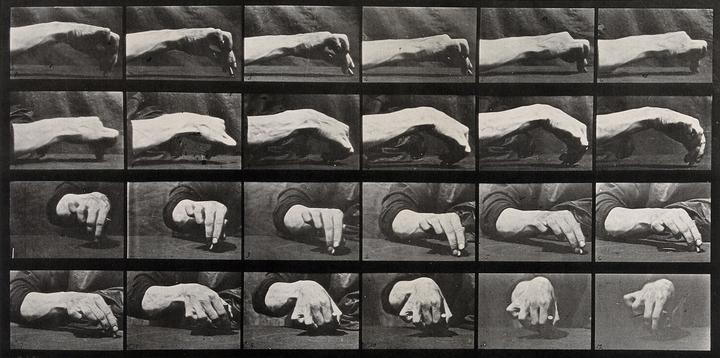Motor Control
Apr 27, 2016
 Muybridge. Hand movement.
Muybridge. Hand movement.
We use our hands and arms countless times every day – skillfully, yet effortlessly. By using the upper limbs as a model system and combining behavioral, perceptual, and cognitive tasks I have been able to uncover how the senses influence motor control in both healthy participants and special populations (see my work on autism, multiple sclerosis, head trauma, and Parkinson’s Disease).
Moreover, by bringing a chemical senses perspective to study actions, I was among the first to characterize how smell influence our movements (see the first paper on odor-motor interactions and flavor).
Recently, I analyzed movements in utero, to find pre-birth markers (such as handedness), offering a promising strategy for translational applications.
Related
- Motor Signatures in Autism Spectrum Disorder: the Importance of Variability
- Kinematics of the Reach-to-Grasp Movement in Vascular Parkinsonism a Comparison with Idiopathic Parkinson’s Disease Patients
- Body Odors Promote Automatic Imitation in Autism
- Implicit Olfactory Processing Attenuates Motor Disturbances in Idiopathic Parkinson's Disease
- Chemosensation and COVID-19
Publications
Task-irrelevant odours affect both response inhibition and response readiness in fast-paced Go/No-Go task: the case of valence
Whether emotional stimuli influence both response readiness and inhibition is highly controversial. Visual emotional stimuli appear to …
Psychometric properties of the Spanish version of the Edinburgh Handedness Inventory in a sample of Chilean undergraduate
An individual’s nervous and cognitive systems are lateralized, and handedness represents a behavioral mani- festation of such …
Sex Differences in Body Ownership in Adults With Autism Spectrum Disorder
A strong male prevalence has been observed in autism spectrum disorder (ASD) since its definition, but the behavioral manifestations of …
In Sync or not in Sync? Illusory Body Ownership in Autism Spectrum Disorder
Background A fundamental aspect of self-consciousness is body ownership, which refers to the experience that our body and its parts …
The Functional and Developmental Role of Imitation in the (A)typical Brain
Commentary on Keven & Akins Neonatal imitation in context: Sensorimotor development in the perinatal period Keven & Akins …
The Origin of Human Handedness and its Role in Pre-Birth Motor Control
The vast majority of humans are right-handed, but how and when this bias emerges during human ontogenesis is still unclear. We propose …
Cross-Modal Interactions between Olfaction and Vision When Grasping?
This study used kinematics to investigate the integration between vision and olfaction during grasping movements. Participants were …
Motor Signatures in Autism Spectrum Disorder: the Importance of Variability
In a recent study, Wang et al. (J Neurophysiol 113: 1989–2001, 2015) used a precision grip force control task to unveil the …
Kinematics of the Reach-to-Grasp Movement in Vascular Parkinsonism a Comparison with Idiopathic Parkinson’s Disease Patients
The performance of patients with vascular parkinsonism (VPD) on a reach-to-grasp task was compared with that of patients affected by …
Selecting Food. The Contribution of Memory, Liking, and Action
The goal of the present experiment was twofold identifying similarities and differences between flavour memory and visual memory …
Visuo-Olfactory Integration during Action Observation and Execution of Reach-to-Grasp Movements
Observing the actions of others prompts the motor system to perform a similar action. However, visual cues are not the only source of …